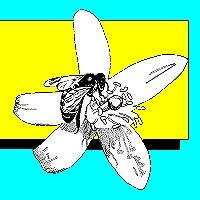APIS Volume 2, Number 2, February, 1984

In this issue
- The Pollination Picture
- Being Credible to Get Credit
THE POLLINATION PICTURE
There's been a lot of talk over the years about the value of bee pollination to agriculture, but few hard figures. Perhaps the best reference is what some call the "Pollination Bible," S.E. Macgregor's book, Insect Pollination of Cultivated Crop Plants, Agricultural Handbook 496, published in 1976 by the Agricultural Research Service (ARS). This book is currently available from the U.S. Government Printing office or one of its bookstores. The above volume is the source of the often-heard quotation that approximately one-third of the U.S. diet is directly or indirectly dependent on insect-pollinated plants. Unfortunately, this has been at best only a vague reference to the actual value of bees as pollinators, because few numbers were available to prove the point.
Dr. Marshall D. Levin, present director of the Carl Hayden Bee Research Center, for a long time chief bee scientist on the U.S. Department of Agriculture's National Program Staff, however, has recently published some hard facts, backed up by solid numbers on the honey bee's value to agriculture. Now bee scientists and beekeepers have something concrete to point to when asked about the value of bee pollination to agriculture. The bottom-line figure is almost 19 billion dollars, or 143 times the total value of honey and wax produced by bees.
Dr. Levin's figures are derived from analyses of bee pollination to fruits and nuts, seeds and fiber, and vegetable seed and animal production indirectly dependent on bee pollination. Of the 25 or so fruits and nuts, mentioned, apples and almonds lead the list with values of 757 and 473 million dollars respectively, followed by peaches (368), strawberries (288), cantelopes (161) and watermelons (149). The value to citrus is 155 million dollars and to pickles (processed, 100; fresh, 116). In the seeds and fiber category, soybeans lead the way, valued at 1.3 billion dollars. This figure is considered conservative because only ten percent of potential soybean pollination is realistic! Sunflowers (410 million dollars), cotton (seed, 57; lint, 407) and alfalfa (114), and finally, vegetable seeds (60) follow in order of importance.
Of the five billion dollars accounted for by crops resulting from seed requiring bee pollination, alfalfa hay leads (4.9 billion), followed by onions (346 million) and cabbage and carrots at 175 and 161 million respectively. Cattle and calves are also considered by Dr. Levin to be indirectly dependent on bee pollination, because 60 percent of all hay fed to cattle and dairy herds is alfalfa. A conservative 10 percent potential value of hay fed to cattle and calves is 5.5 million dollars, while that responsible for liquid milk production is 1.6 million.
Dr. Levin published his article to show the relative value of bee pollination to U.S. agriculture and to communicate to entomologists, public officials and the general public the "real" value of the beekeeping industry which at present supplies much of bee pollination free of charge.. As Dr. Levin says, "Although the total value of crops and commodities affected by the pollinating activities of bees has reached an impressive figure on a national basis, the beekeepers who supply most of this service receive very little monetary compensation for it. A study made by the U.S. International Trade Commission (1976) revealed that, of the total beekeeping incomes earned by 118 commercial beekeepers in various states during 1971-1975, the proportion derived from pollination fees averqaged only 9.7 percent." Given these facts, those who counsel that beekeepers can simply raise pollination fees to cure the present financial woes caused by dislocations in the world honey market, are not informed about the true nature of beekeeping in this country.
All this is to say the beekeeping industry has not done a good job communicating its value to agriculture. Fortunately, Dr. Levin's facts and figures are the ammunition so critically needed to raise public consciousness about how much beekeeping really contributes to the nation's food supply. I hope all beekeepers will use these figures judiciously in the future to tell the beekeeping industry's true story. Dr. Levin's article is published in the Winter, 1983 Bulletin of the Entomological Society of America.
CREDIBLE CREDIT
Few persons in the agricultural economy today can do without some form of credit. Beekeepers are no exception it seems; I get lots of questions about obtaining credit for beekeeping operations, but have few answers. History shows lenders are extremely hesitant to loan capital, when their collateral is only a white box full of honey bees. The current state of world honey prices is no help either. The bottom line is that credit is far more difficult to obtain for beekeepering than other kinds of agricultural operations. That means the beekeeeper had better have his or her "act together," when approaching a lending institution. A recent article by Commmisioner Doyle Conner in the Florida Market Bulletin discusses borrowing and the increasing emphasis lenders (private bankers, Federal Land Bank, Production Credit Associations) are putting on "M's." These are not M1 and M2, the money supply figures watched carefully by the Federal Reserve, but the M's of management and marketing. Borrowing can no longer be taken for granted. And recently lenders are looking much more carefully at another M, according to Commisioner Conner
"margin for adversity,... to make a loan risk acceptable, the lender wants assurance that the applicant for a loan will be able to pay his operating costs, meet his debt requirements, cover his living expenses and have a significant margin to cover unexpected occurrence."
The key to minimizing the margin for adversity, the Commisioner says, is to adopt and stick with accurate and complete business records. The better the records, the easier it becomes to keep abreast of strength and weakness in an operation. This will also make many agriculturalists (and beekeepers are no exceptions) realize that production skills are taking a back seat to management and marketing in deciding who gets financing.
When it comes to deciding where to obtain agricultural credit, the answer increasingly is the Production Credit Associations (PCAs). The role of these associations in farm financing is detailed in the September-October issue of Florida Food and Resource Economics, No. 54. According to the publication, there has been a decline in commercial bank contributions to non-real estate agriculture in Florida, and more than likely PCAs will provide over two-thirds of this credit by the late 1980s. To see why this is so, contact your county Cooperati ve Extension Office and ask for a copy or write: Rodney Clouser, Food and Resource Economics Dept., G-105, McCarty Hall, Gainesville, FL 32611.
The publication also lists the PCA areas in Florida, the members served and loans outstanding in 1978 and 1982. It also reveals that the PCAs in Florida appear to be more sound than those found in other areas of the country. Nine PCAs serve Florida: Big Bend, Central Florida, Gulf Atlantic, Mid Florida, North Florida, Northeast, Panhandle, South Florida, and Southwest. To find the address or telephone number of the PCA nearest you, contact your county Cooperative Extension Office. Sincerely,
Malcolm T. Sanford
Bldg 970, Box 110620
University of Florida
Gainesville, FL 32611-0620
Phone (352) 392-1801, Ext. 143 FAX: (352)-392-0190
http://www.ifas.ufl.edu/~entweb/apis/apis.htm
INTERNET Address: MTS@GNV.IFAS.UFL.EDU
©1984 M.T. Sanford "All Rights Reserved

















